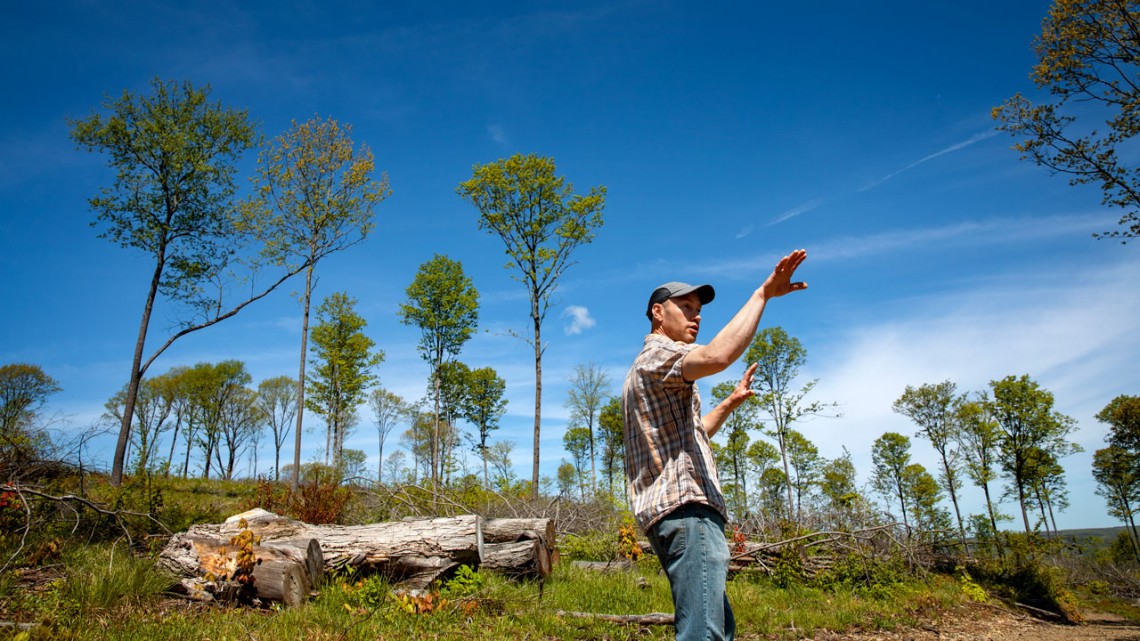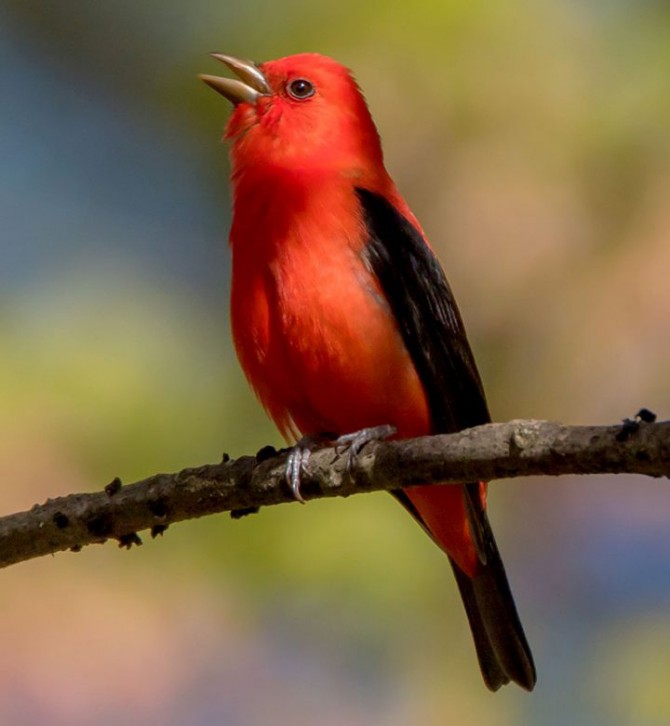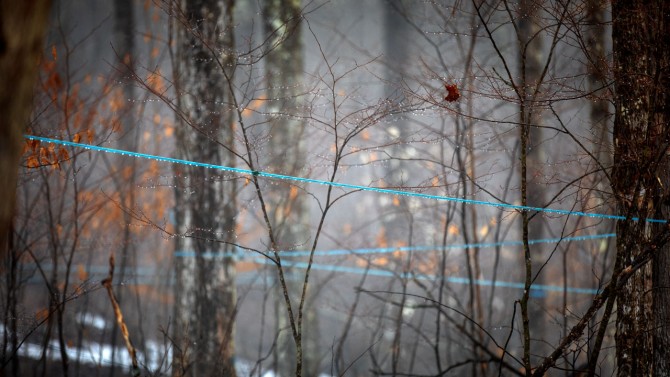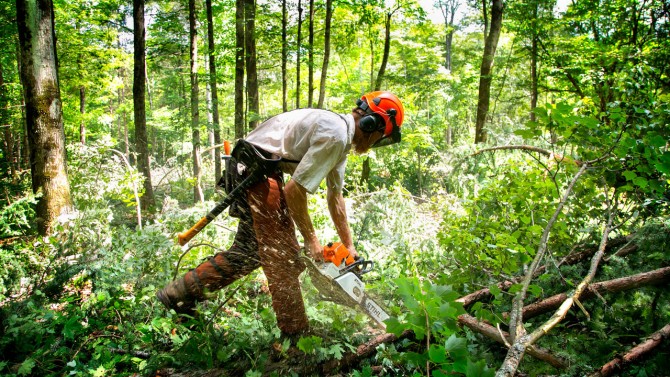
Aaron Wightman, operations manager at the Arnot Research Sugarbush, tours an area of Arnot Forest that has been managed to allow new tree growth.
Turning maple syrup forests into bird-friendly habitat
By Alison Haigh
High in the branches of a maple tree sit the tattered remains of a muddy, grassy bird nest. I train my binoculars on the small lump, but it was built the previous year and is very much empty. Closer to eye level, it’s harder to miss the metal spigot and tangle of blue tubing attached to the tree’s trunk. This tree is one of the 6,000 tapped for Cornell University’s signature maple syrup, and last year it also raised a family of birds.
Birds and maple syrup share the same critical ingredient: healthy northeastern forests. Every year, millions of birds breed, feed and fledge in the same forests that are tapped for syrup (called “sugar bushes”). As long as a sugar bush stays tapped, it will remain a forest and not be cleared for development.
Now the Cornell Lab of Ornithology is partnering with the Cornell Maple Program to help sugar bushes meet their full potential for bird habitat, sweetening the deal for birds and for the bottom line in the university’s own sugar bush.
From maple monocultures to bird-friendly forests
Maple-syrup producers exert considerable control over the habitat in a sugar bush. What is good for birds in a forest is also good for maple producers in the long run: the health and sustainability of the crop.
Aaron Wightman ’97 oversees operations at the Arnot Research Forest in a Cornell University-owned forest south of Ithaca. After learning Audubon Vermont has worked with nearly 40 of that state’s maple syrup producers on the Bird-Friendly Maple Project since 2014, he approached then-Cornell Lab of Ornithology conservation biologist Ron Rohrbaugh about managing a sugar bush for birds.
Wightman was interested in helping the birds, but also in helping the forest he manages.
The understory of the oldest part of the Arnot sugar bush was thinned decades ago and deer have kept the shrub layer from regenerating, Wightman explains as we walk through the Cornell research forest on a delicately sunlit May morning. Here, slender maples tower over us like an arched cathedral ceiling. Tiny beech and hornbeam seedlings pop out of the leaf litter – but there is nothing but empty space between the canopy and forest floor.
Forest managers aim for an ideal diversity of tree species at a diversity of ages, with layers of branches and leaves at the top, middle and bottom. Without younger generations of trees growing up underneath the canopy layer, the entire forest community faces an abrupt decline when all those oldest-generation trees begin to die.
Birds suffer, too, from a lack of diversity in sugar-bush habitat. For example, without a conifer component among the maple trees, birds like the blue-headed vireo, blackburnian warbler and sharp-shinned hawk are missing valuable nesting habitat. Fruiting trees and shrubs in a sugar bush, like black cherry, also provide critical energy supplies for birds fueling up for migration.
Next to the monoculture in Arnot Forest stands a plot that is a perfect model for bird-friendly management. The bright blue tubing disappears and reappears among the thick understory, winding around a few snags with holes drilled out by woodpeckers. There are more than just maples here; we stop to admire a black-throated green warbler flitting around in a hemlock, and a scarlet tanager in an oak tree.
Conservation biologist Steve Hagenbuch, who heads up Audubon Vermont’s Bird-Friendly Maple Project, says sugar bushes that contain at least 25 percent nonmaple trees support a greater diversity and abundance of birds than stands growing only maples. And he says syrup producers in the Audubon Vermont program are finding that managing a sugar bush for tree diversity is good for sugaring sustainability, too. A University of Vermont study found that sugar bushes with a bird-friendly ratio of tree diversity experienced insect outbreaks that were significantly shorter and less intense than in maple monocultures.
“Is that a coincidence?” Hagenbuch asks rhetorically. “I don’t think so. I think that speaks to a healthy, functioning forest, thanks to its structure and composition.”
Bringing back the forest for birds
The quaint, colonial scenes on maple syrup bottles are misleading. Maple syrup is big business.
By the barrel, syrup costs more than oil. Products like maple-derived alcohol, candies and even sports drinks have exploded in popularity. New York state alone taps more than 2 million trees, and its maple products were worth more than $30 million last year.
But the boom in sugar bushes, as another form of farming monoculture, is compounding a tree diversity problem in the Northeast’s forests.
Throughout the 1800s, settlers cleared nearly 90% of all forests in the Northeast for farmland, only to suffer season after season of poor yields in their harvests. After the settlers abandoned their farmland, the forests began to grow back. But wave after wave of invasive species, forest pests and diseases stunted the growth of young trees, leaving many forests lacking in successive generations of native trees. The irony, noted in the 2016 State of the Birds Report, is this: “In the East, there is more forest today than there was 100 years ago, yet forest stands lack the diversity of young and old trees that makes for prime bird habitat.”
With habitat loss and degradation looming as the greatest threats to birds today, sugar bushes have the potential to offer a big conservation footprint for birds.
“Conservation of anything – birds, habitat, anything – requires an all-hands-on-deck approach,” Hagenbuch says. “We can’t rely on protected areas, or even the goodwill of people interested in wildlife. We need to integrate [bird conservation] into our businesses, create financial incentives and encourage people to think about the role that their land management has in conservation.”
Bird-friendly maple syrup is only one part of how the food production systems of modern society can help address the massive loss of bird habitat. After all, the very same scarlet tanagers that spend summer in sugar bushes in New York, Vermont and Quebec fly to South America for the winter, where they may look for habitat among shade-grown coffee farms in Colombia.
Ultimately, Wightman hopes the sugar bush in Arnot Forest will be a model for bird-friendly maple production in New York, and for the international importance of sustainable food production.
“Any healthy forest has a healthy bird population,” he says. “That’s how we should grow all our food.”
Alison Haigh is a senior majoring in environmental science at Cornell University and a freelance writer based in Ithaca, New York.
This article originally appeared in the spring 2019 issue of Living Bird magazine, produced by the Cornell Lab of Ornithology.
Media Contact
Get Cornell news delivered right to your inbox.
Subscribe





